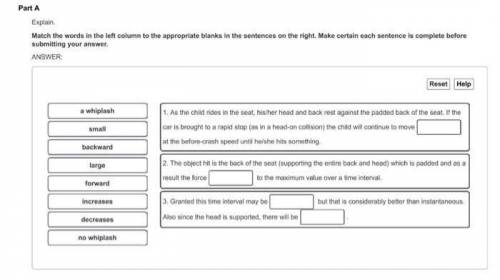
Physics, 07.03.2020 04:36 rlumanlan549
Match the words in the left column to the appropriate blanks in the sentences on the right. Make certain each sentence is complete before submitting your answer. ResetHelp small backward a whiplash large no whiplash forward decreases increases 1. As the child rides in the seat, his/her head and back rest against the padded back of the seat. If the car is brought to a rapid stop (as in a head-on collision) the child will continue to move at the before-crash speed until he/she hits something. 2. The object hit is the back of the seat (supporting the entire back and head) which is padded and as a result the force to the maximum value over a time interval. 3. Granted this time interval may be but that is considerably better than instantaneous. Also since the head is supported, there will be .

Answers: 2
Another question on Physics

Physics, 22.06.2019 06:00
Explain earth's motion, using the terms "precession" and "rotation" in your answer.
Answers: 1


Physics, 22.06.2019 15:40
Question 1 what is amperage? is the rate of doing work. is the rate of flow of protons in electric current. represents the amount of pressure behind electron flow. is the rate of flow of electrons in electric current. 2 points question 2 what is voltage? is the rate of doing power. represents the amount of pressure behind electron flow. is the rate of doing work. is the rate of flow of electrons in electric current. 2 points question 3 what is power? is the rate of flow of protons in electric current. is the rate of flow of electrons in electric current. is the rate of doing work. represents the amount of pressure behind electron flow. 2 points question 4 if we multiply volts times amps we get what? power circuit work current 2 points question 5 what are two ways alternating currents are similiar? in both ac and dc electrons flow in the same pattern. in both ac and dc, the flow of electrons changes directions back and forth. both ac and dc are only possible in certain materials with atoms that will allow electron flow. both ac and dc involve the flow of electrons. 4 points question 6 how does the flow of electrons flow in an alternating current? the flow of electrons is always slower in an alternating current than within a direct current. the flow of electrons is not constant and forward; it changes direction back and forth. electrons flow from from a higher affinity to that of a lower affinity. electron flow is constant and only in a forward direction. 2 points question 7 what is the flow like in a direct current? the flow of electrons is not constant and forward; it changes direction back and forth. the flow of electrons is constant and only in a forward direction. the flow of electrons go from a higher affinity to a lower affinity. the flow of electrons are always faster in a direct current. 2 points question 8 how is an electric current able to flow? electrons flow from the higher affinity to lower affinity and electrical current is generated. protons flow from the higher affinity to lower affinity and electrical current is generated. the movement of protons from one atom to another leads to an electric charge. the movement of electrons from one atom to another atom in a line results in a flow of electric current. 2 points question 9 how do electrons move from the two different types of metal in a battery? protons flow from the metal with the lower affinity to the metal with higher affinity and electrical current is generated. electrons flow from the metal with the lower affinity to the metal with higher affinity and electrical current is generated. electrons flow from the metal with the higher affinity to the metal with lower affinity and electrical current is generated. protons flow from the metal with the higher affinity to the metal with lower affinity and electrical current is generated.
Answers: 2

Physics, 22.06.2019 16:30
Iron is a transition metal with multiple oxidation numbers. (answer the following) a. what is the iron (ii) ion? how does it differ from the iron (iii) ion? b. if iron were to bond with oxygen, predict the formula for each oxidation number of iron. c. how would each formula be named?
Answers: 2
You know the right answer?
Match the words in the left column to the appropriate blanks in the sentences on the right. Make cer...
Questions


Arts, 12.04.2021 15:50

History, 12.04.2021 15:50

History, 12.04.2021 15:50

Social Studies, 12.04.2021 15:50

Mathematics, 12.04.2021 15:50

Mathematics, 12.04.2021 15:50

Mathematics, 12.04.2021 15:50




Advanced Placement (AP), 12.04.2021 15:50

Mathematics, 12.04.2021 15:50


Law, 12.04.2021 15:50


English, 12.04.2021 15:50

Mathematics, 12.04.2021 15:50





